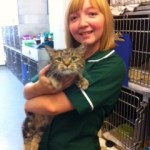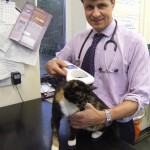Meet Molly a 9 year old Golden Retriever, who had emergency surgery recently for a womb infection (pyometra). Womb infections generally occur a couple of months after the season has finished, and make the dogs feel very unwell, with excessive drinking, loss of appetite and vomiting. The womb fills up with pus like a ‘string of sausages”, and there may or may not be a discharge depending on whether the cervix is open or closed. Unfortunately they do not respond to antibiotics alone and emergency surgery must be performed to remove the infected womb.
Dogs do not go through a menopause, and will keep coming into season all of their life. The risk of a womb infection increases with increasing age, and so we recommend that all female dogs are neutered if possible.
Despite her major surgery Molly was up and around the following day, and her appetite was impressive. She was showing off her paw shaking skills in the kennels for her photo !
Categories
Tags
cat
chiswick
chocolate
choose
choosing
clip
dental
disease
dog
dogs
ear
firework
fireworks
heart
heart failure
infection
kitten
kittens
lilly
litter
Lungworm
nails
neutering
noise
passport
pet
poison
poisoning
pregnancy
puppy
puppy vaccinations
scan
select
slugs
snails
surgeon
surgery bite wound
toilet
train
training
ulltrasound
ultrasound
vet
veterinary
vets





